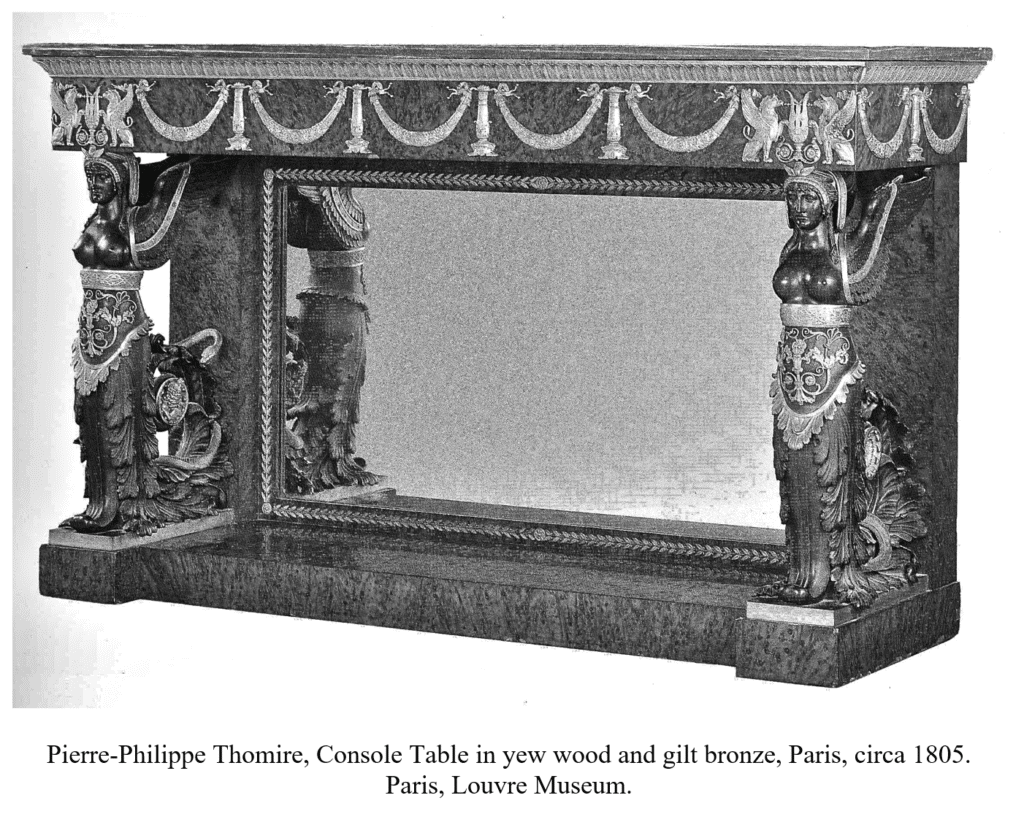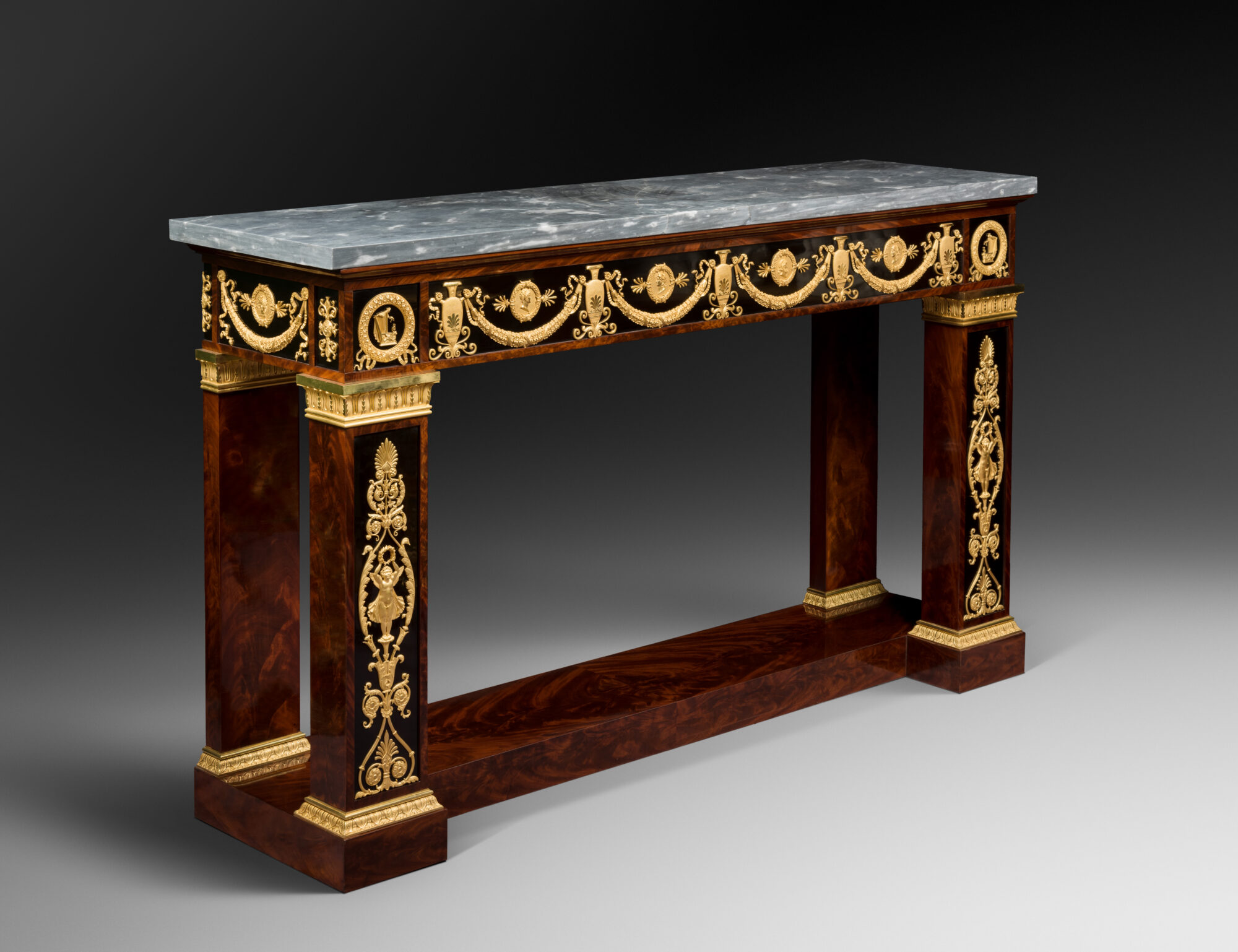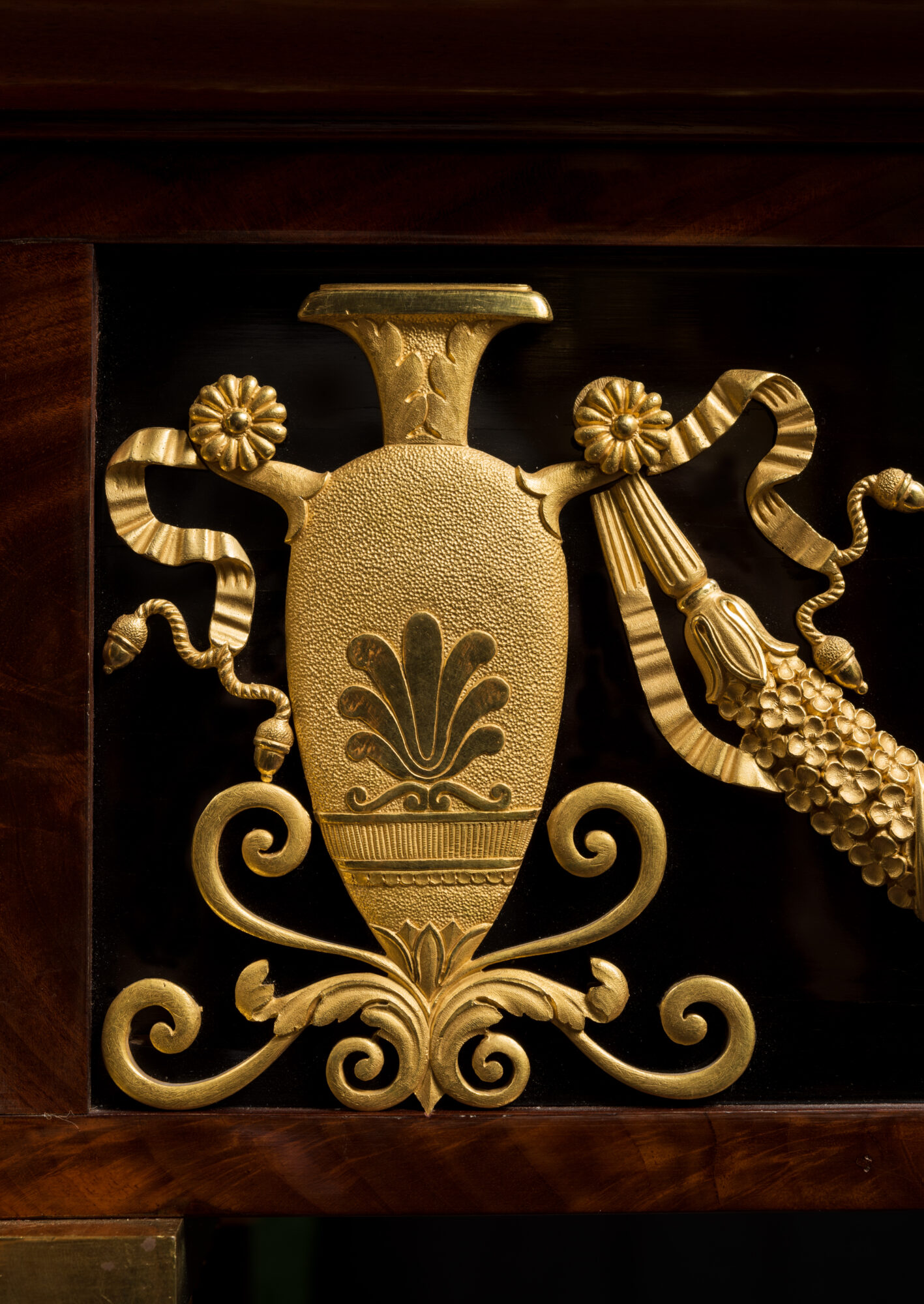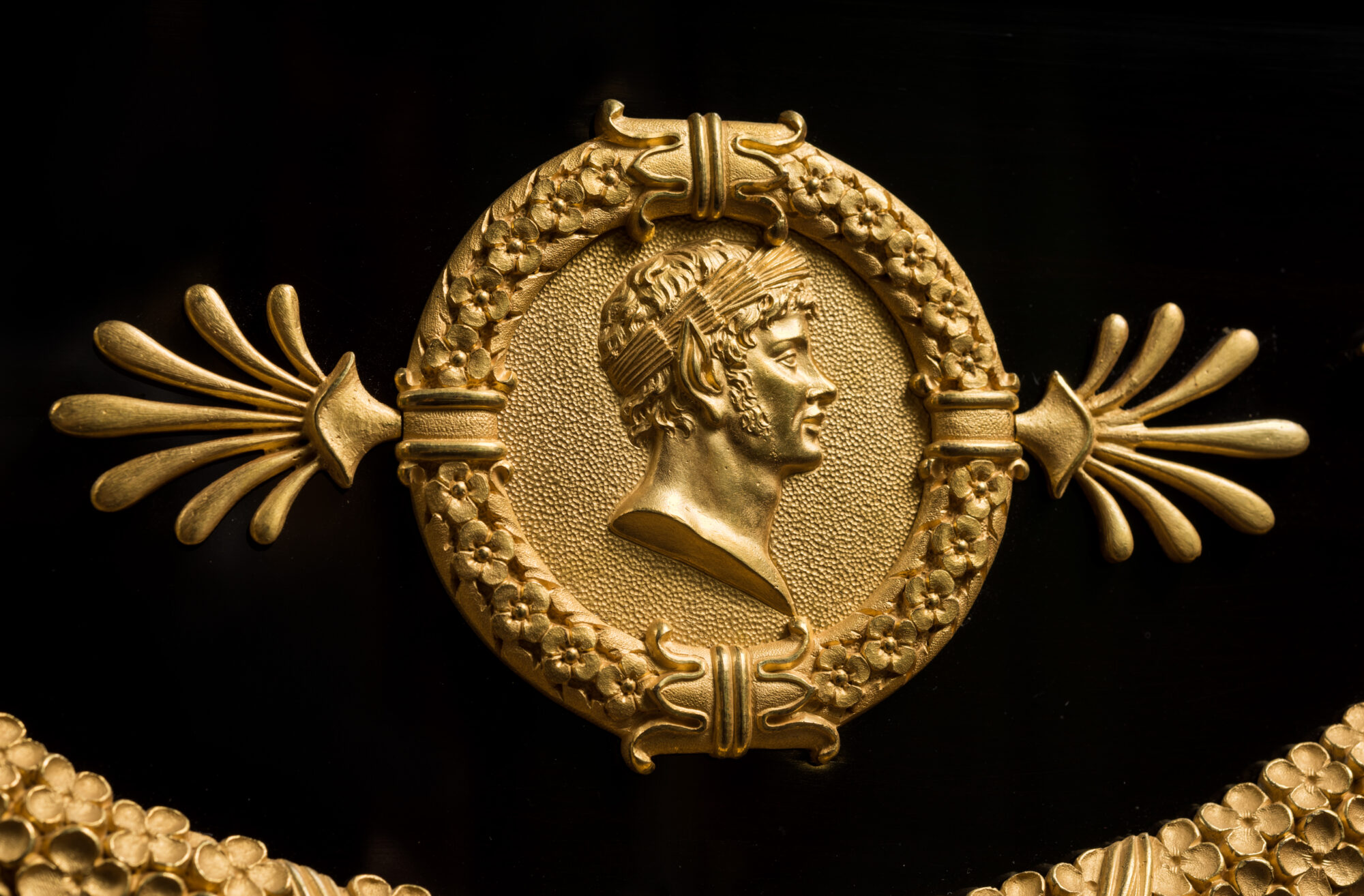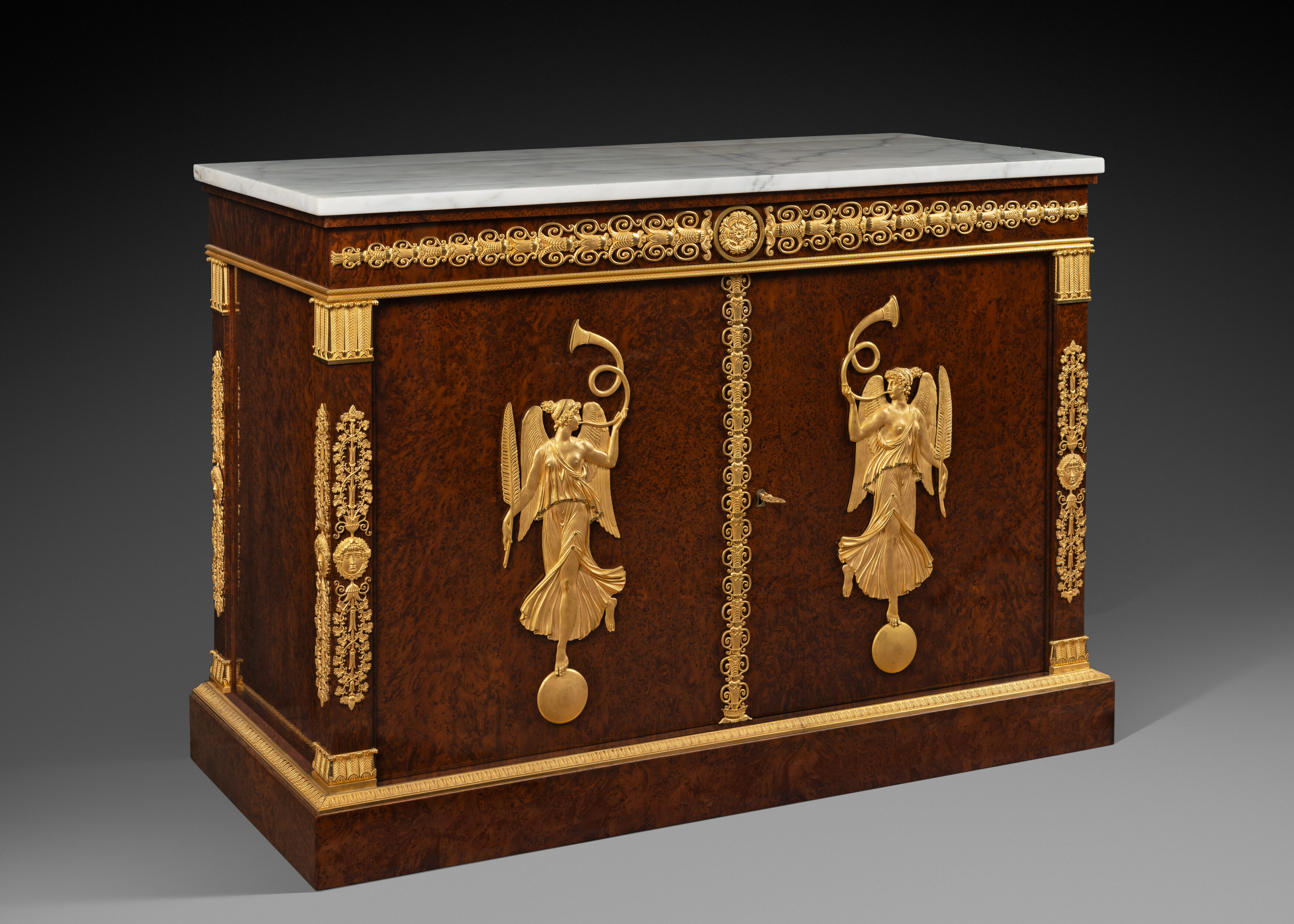Exceptional Mahogany Console with Ebony Veneering and Finely Chased and Gilt Bronze Mounts

Console attributed to the cabinetmaker Jacob-Desmalter
Bronze Mounts attributed to Pierre-Philippe Thomire
Paris, Empire period, circa 1810
Iron branding of the Château of Rosny: “R15″
Provenance:
– Probably commissioned circa 1810 by Edmond de Talleyrand-Périgord, future Duke de Dino, for the château de Rosny.
– Formerly in the collection of the Duchesse de Berry at the château de Rosny, Rosny-sur-Seine.
– Transferred after 1830 to Schloss Brunsee in Graz, Austria.
– Thence by descent in the Lucchesi-Palli family collection.
This exceptional and unusually large rectangular console table is one of the most elaborate ever produced by the famous Jacob-Desmalter workshop. Entirely veneered with fine mahogany panels, its architectural design comprises four straight pilasters, with gilt bronze bases and capitals chased with stylised leaves, linked by a solid recessed base, with a rectangular entablature. The façade, supports and sides of the entablature feature rectangular ebony panels juxtaposed with mahogany veneering, highlighted by finely chased gilt bronze mounts. The supports feature large low-relief depictions of putti crowning themselves amidst leaves, scrolling, palmettes and rosettes. The band is adorned with ribbon-tied wreaths and stylised motifs, as well as with alternating antique-style amphorae and scrolling, linked by ribbon-tied garlands and mille-fiori swags. Above them are medallions featuring the profiles of figures from classical mythology. The console is surmounted by a magnificent blue turquin marble top. The wood beneath the marble top shows the branding “R15” from the château of Rosny.
While it bears no stamp, the present console may confidently be attributed to Jacob-Desmalter; its finely chased gilt bronze mounts may be attributed to Pierre-Philippe Thomire, the most renowned Parisian bronze caster of the time. The design of the present console is remarkably similar to that of a stamped console pictured in Jean-Pierre Samoyault, Mobilier français Consulat et Empire, Editions Gourcuff, Paris, 2009, p. 211, fig. 360. Its gilt bronze mounts featuring antique-style motifs alternating with flower garlands, are reminiscent of those of other exceptional pieces whose bronze mounts are attributed to Thomire. Among them is a console sold circa 1805 to Prince Nicolas Esterhazy by the marchand-mercier Martin-Eloi Lignereux, and today in the Budapest Museum of Decorative Arts (illustrated in J-P. Samoyault, op.cit., 2009, p. 107, fig. 182); a second console, consigned by Thomire in 1807, is in the Louvre Museum in Paris (illustrated in D. Alcouffe, A. Dion-Tenenbaum and A. Lefébure, Le Mobilier du Musée du Louvre, Tome 1, Moyen-Age, Renaissance, XVIIe-XVIIIe siècles (ébénisterie), XIXe siècle, Editions Faton, Dijon, 1993, p. 309, catalogue n° 105).
This spectacular console is typical of important commissions the Jacob-Desmalter workshop received from the most important figures of the day, often people in the imperial or royal circle. During the late 1810’s and the early years of the following decade, the taste for luxury was particularly evident in the furnishings and objets d’art in the château de Rosny, when it belonged to the Duchesse de Berry. The castle’s decoration and furnishings were admired by contemporaries, among them the Duchesse de Maillé (1787-1851), who noted: “Nothing compares to the furnishings of Rosny: each floor and every room is equally recherché and beautifully decorated. (The Duchesse of Berry) has gathered here everything she loves, everything the king gives her and everything she herself purchases. As a result, Rosny is filled with furniture, but one must admit that Madame has excellent taste. Everything in her home is wonderfully chosen. She recognises and appreciates beauty like an Italian.” (Blanche-Joséphine Le Bascle d’Argenteuil, Duchesse de Maillé, Souvenirs des deux Restaurations, Paris, Perrin, 1984, p. 247).
While the console is known to have stood in the château de Rosny in the 1820’s, since it bears the marque au fer of the château inventory, “R” followed by the number “15” which designated the room where it was located, the fact that it was made many years earlier suggests a former provenance that is not known today. The most likely hypothesis is that the present console was commissioned for Rosny circa 1810 by Edmond de Talleyrand-Périgord, and that it was sold with the château, thus entering the collection of the Duke and Duchesse de Berry. This is supported by the fact that a pair of similar, but smaller, consoles, is recorded; in a private collection, they also bears the mark “R15”. This pair of small consoles, stamped Jacob-Desmalter, is mentioned in a memoir today in the Archives nationales, which mentions that the furniture maker delivered it in February 1821 for the Salon des Princes in the château de Rosny. It is likely that this pair of consoles completed an existing ensemble and that at that time the present console already stood in the Salon des Princes.
Château de Rosny:
Built in the late 16th century for Maximilien de Béthune, Duke de Sully, then Henri IVth’s Superintendant of Finances, the château de Rosny, located in Rosny-sur-Seine near Paris, was one of the finest properties in Ile de France in the late 19th century. It remained in the Bethune-Sully family until 1718, at which time the castle was sold to Count François Olivier de Sénozan. Sixty years later, the President de Sénozan’s granddaughter married Count Joseph-Archambaud de Talleyrand-Périgord, the younger brother of Napoleon’s minister Charles-Maurice de Talleyrand-Périgord. Rosny then became the property of the Talleyrand-Périgord family. The castle was confiscated during the Revolution, later being returned to the Talleyrands. Edmond de Talleyrand-Périgord, the future Duke de Dino, inherited Rosny in 1808. Ten years later, the property was purchased by the Duke de Berry, the son of the Count d’Artois; he died in February 1820 and his widow, Marie-Caroline des Deux-Siciles, Duchesse de Berry, completely remodelled the property, entrusting the project to her favourite architect, Joseph-Antoine Froelicher (1790-1866). She refurnished it, adding to the furnishings purchased by her husband when he acquired the domain in 1818.
The Duchesse de Berry:
Marie-Caroline-Ferdinande-Louise de Naples et de Sicile, Duchesse de Berry (1798-1870). Born in Caserta near Naples, in 1816 she married Charles-Ferdinand d’Artois, duke de Berry, the second son of the Comte d’Artois (future Charles X and brother of Louis XVIII). They had four children, including Louise-Marie-Thérèse d’Artois, who married the Duc de Parme, and Henri d’Artois, Duc de Bordeaux and Comte de Chambord, the legitimist pretender to the French throne. After the death of her husband, the Duchesse de Berry settled in the Tuileries Palace and furnished the château de Rosny, where she often stayed. She followed Charles X into exile in England, and met Hector Lucchesi-Palli, the Duke della Grazia (1808-1864), whom she secretly married in 1831. She then settled in Schloss Brunsee in Austria, staying from time to time in Venice where she acquired the Vendramin Palace. She died at Brunnsee on April 16, 1870.
Jacob-Desmalter (1770 - 1841)
François-Honoré-Georges Jacob, dit Jacob-Desmalter may be considered to be the most important Parisian chair makers of the first quarter of the 19th century. The youngest son of the famous cabinetmaker Georges Jacob (1739-1814), in 1798 he married Adélaïde-Anne Lignereux, the daughter of the famous merchant Martin-Eloi Lignereux. He first became known for his talent as a draughtsman, and in 1796, he went into partnership with his older brother Georges II Jacob (1768-1803). Together they took over their father’s workshop in the rue Meslée, calling their firm Jacob Frères. After the death of his brother, Jacob Desmalter went into partnership with his father, who had begun working again, and changed his stamp. For nearly a decade, they were important suppliers of the Imperial Garde-Meuble, as well as of influential collectors of the time. However, in 1813 the Jacob firm went bankrupt, due largely to the Imperial administration’s failure to pay them regularly. In 1825, after several failed attempts at recovery, he sold his business to his son in exchange for a comfortable life annuity of 6,000 francs per year. Finally free of the demands of running a business, he began to travel, going to England, where George IV asked him to help decorate Windsor castle. He died in the rue Cadet in Paris, on August 15, 1841.
Pierre-Philippe Thomire (1751 - 1843)
Pierre-Philippe Thomire was the most important Parisian bronzier of the last quarter of the 18th century and the first decades of the following century. Early on in his career he worked for Pierre Gouthière, ciseleur-fondeur du roi, and toward the mid-1770’s began working with Louis Prieur. He later became one of the bronziers attached to the Manufacture Royale de Sèvres, creating the bronze mounts for most of the important creations of the day. After the Revolution, he purchased the stock of Martin-Eloi Lignereux, thus becoming the most important suppliers of furniture bronzes for châteaux and Imperial Palaces. In addition, he worked for a wealthy private clientele, both French and foreign, including several of Napoleon’s Marshals. Thomire retired in 1823.

